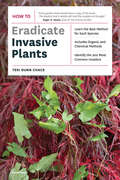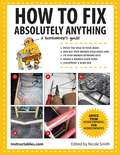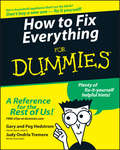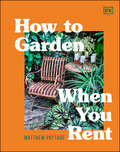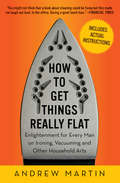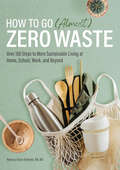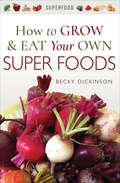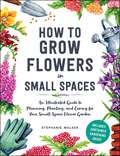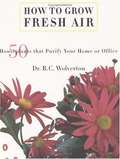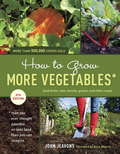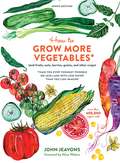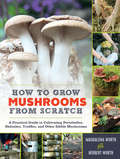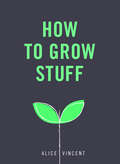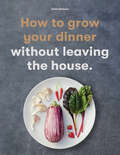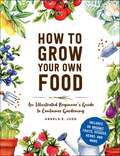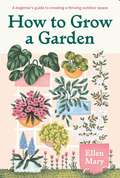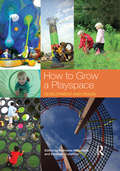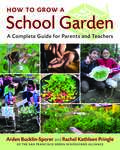- Table View
- List View
How to Eradicate Invasive Plants
by Teri Dunn Chace“Every garden shed should have a copy of this book. The wisdom that it wields will hold the invaders at the gate.” —Roger B. Swain, The Victory GardenHow to Eradicate Invasive Plants offers a clear, practical solution to the increasingly common problem of invasive plants. Clearly written and easy-to-use, Teri Dunn Chance shows you how to recognize more than 200 common invasive plants and offers organic and responsible chemical eradication options for each species. With this reference on their shelves, gardeners, landscapers, and managers of public and private land across the country can confidently tackle the invasive plants to make room for a sustainable plant community!
How to Fix Absolutely Anything: A Homeowner?s Guide
by Instructables. Com Nicole SmithThe one book that shows you how to fix anything anywhere in your home!There are a million things that can go wrong in your home. Faucets leak. Floorboards creak. Paint flakes. Chairs break. With How to Fix Absolutely Anything, you'll have step-by-step instructions to tackle even the most confounding repairs in your home, including: Installing a toilet Replacing the belts on your washer and dryer Patching up a hole in the wall Bringing a power adapter back to life Re-covering chairs Getting wax out of your carpet And many more!From changing lightbulbs to fixing a kitchen cabinet hinge, How to Fix Absolutely Anything is a collection of the most indispensible advice and tips from people across the world who face the same problems you do. Hundreds of color photographs and easy-to-follow instructions make this book perfect for all levels of experience. It's a no-brainer for any homeowner, and the one gift to get any friend, family member, or loved one living on their own for the first time. Broke the microwave handle and don't know what to do? With How to Fix Absolutely Anything, the solution is only a few pages away.
How to Fix Everything For Dummies
by Gary Hedstrom Peg Hedstrom Judy Ondrla TremoreThe fun and easy way to repair anything and everything around the house For anyone who's ever been frustrated by repair shop rip-offs, this guide shows how to troubleshoot and fix a wide range of household appliances-lamps, vacuum cleaners, washers, dryers, dishwashers, garbage disposals, blenders, radios, televisions, and even computers. Packed with step-by-step illustrations and easy-to-follow instructions, it's a must-have money-saver for the half of all homeowners who undertake do-it-yourself projects.
How to Garden When You Rent: Make It Your Own *Keep Your Landlord Happy
by Matthew PottageTransform your garden into your own and feel at home even when you are renting.Your outdoor space does not need to look dull when you are renting your home. You can still brighten it up with a tailored gardening guide designed especially for your gardening needs. Find some gardening inspiration! This simple, easy-to-follow gardening book will help you achieve an impressive garden. Inside, you&’ll find: • Three central chapters focus on different rental lease lengths, each showcasing key plant types. • Gallery of inspirational ideas for front and back gardens, balconies and patios, and any other available outdoor spaces the reader can plant up and enjoy. • Essential planning chapter to encourage readers to identify what they can achieve in their rental garden, how much time they have to make it happen, and how much money they want to spend. • &“Working with the Seasons&” guide to help readers identify what they can do as soon as they move in, depending on the season they start their lease. • Maintenance chapter showing renters how to keep their garden in good shape (including weeding, cleaning and pruning know-how), so that they can enjoy the garden they now have and feel confident that they can get their deposit back when they leave. Your garden will look beautiful and cared for, and your landlord will be impressed with how healthy and lush your plants look! This must-have gardening reference book is packed with plenty of tips, tricks, and techniques for good gardening maintenance. Creating a magnificent garden oasis is achievable and cost-effective with this book about gardening. Discover ways of turning even the most unloved balcony, yard, or urban garden into a lush, welcoming space that you, your roommates and your friends can enjoy for as long as you choose to live there.How to Garden When You Rent will appeal to renters of all ages who want to make the most of their outdoor space, no matter how long they intend to enjoy it. It is also great for landlords interested in encouraging their tenants to tend to their gardens and keep them in shape.
How to Garden the Low Carbon Way: The Steps You Can Take to Help Combat Climate Change
by Sally NexCreate a beautiful home garden while reducing your carbon footprint along the wayTransform your outdoor space into a low-impact, carbon-absorbing sink with this fantastic gardening guide, packed with ideas to grow a climate-friendly garden that will help protect the planet. Keen on starting your own garden but unsure about your environmental impact? This guide will give you practical advice on which soil to use, plants that are best for absorbing carbon dioxide, low-carbon fertilizers, and cutting out single-use plastic. What&’s more, this garden book is completely backed by scientific research! Share in the delight of eco-conscious gardening when you start using How to Garden the Low Carbon Way as your guide. Explore the benefits of no-dig gardening, how to use fewer plants, using hedges instead of fences, how to grow shrubs that support wildlife, and more! This green gardening book will make growing your own garden easy, enjoyable, and eco-friendly and includes sections on; • How to grow plants that reduce your carbon footprint • Creating a garden that considers the local wildlife • Tips on setting up your garden, low-impact plants, and best fertilizers to use Green Gardening: Low environmental impact This fantastic gardening book is a simple, step-by-step guide to learn about gardening or to reference as your garden grows. You&’ll quickly become acquainted with the benefits of growing a garden that positively contributes to the environment. Plus, you'll have all the fun, rewards a gardening hobby has to offer.
How to Get Things Really Flat: Enlightenment for Every Man on Ironing, Vacuuming and Other Household Arts
by Andrew MartinIncludes actual instructions! “You might not think that a book about cleaning could be funny but this made me laugh out loud” (The Financial Times). For many reasons, men often neglect housekeeping chores—even when they share the house with other humans who wish they could get some help in that department. How to Get Things Really Flat combines witty observations, true tales of family life, useful information that takes the mystery out of such phenomena as dishwashers and vacuums, and answers to timeless questions including: During dusting, where does the dust go?What is the worst thing that can happen while ironing?Is housework therapeutic?How can I impress people with bicarbonate of soda?Aren’t men supposed to be dirty?And more! “A delightfully amusing tale about the joys and tribulations of doing housework that also serves as a very good primer on how to actually do housework . . . His main target audience is men. But women, I think, will also find Martin’s observations funny and many of his tips helpful . . . And if, after laughing your way through Martin’s text, you’re still not into doing housework, he has a tip for that, too: Hire a cleaner.” —Minneapolis Star-Tribune “Martin’s lighthearted but quite handy guide looks at the reasons why men don’t help out around the house as much as they ought to and proposes what can be done about that . . . After reading this offbeat and thoroughly delightful guide to housework, it’s hard to imagine anyone not wanting to give this stuff a try. Martin does what your mother never could: he makes doing chores seem fun, exciting, and rewarding.” —Booklist
How to Go (Almost) Zero Waste: Over 150 Steps to More Sustainable Living at Home, School, Work, and Beyond
by Rebecca Grace Andrews MA, MSYour easy, practical resource on the journey to sustainable living A zero-waste lifestyle can have a profound impact on our environment and the health of your home, and How to Go (Almost) Zero Waste is here to make sustainable living easier, with more than 150 different ways you can make more sustainable choices at home, school, work, and beyond. Learn how to reduce your footprint at your own pace with simple steps like carrying reusable shopping bags, more intermediate steps like mending your own clothes, and major steps like creating a garden-to-cafeteria program at your local schools. How to Go (Almost) Zero Waste offers: Changes big and small—Discover how sustainable living can be a progressive process—one manageable step at a time— that leaves you feeling successful, positive, and eager to do more. Your choice—Decide how you want to use this book, whether it's trying out steps here and there, flipping to sections of interest, or reading the whole thing before you get started—it's up to you. Progress, not perfection—This book will help you take the steps to sustainable living that you are able and comfortable with, based on your budget and lifestyle. Begin the path to more sustainable living with a book that makes it easy and manageable for anyone.
How to Grow & Eat Your Own Superfoods (Superfood)
by Becky DickinsonA step-by-step guide to planting your own fruit and vegetable garden—and growing your own healthy and nutritious superfoods. Gardening is where science meets art, where nature meets nurture and where food and health unite. In an age of clean eating and fad diets, the term superfood has become synonymous with inflated prices and overstated claims about the disease-fighting, anti-aging, life-enhancing powers these foods possess. Sales of fruits and vegetables like kale, beetroot, and blueberries have skyrocketed, encouraging us to spend money on products that have traveled miles around the country or even the globe only to sit in a supermarket wrapped in plastic for days. Becky Dickinson&’s How to Grow & Eat Your Own Superfoods weeds out the hype and unearths the secrets of what makes a food super. Discover a wide array of fruits and vegetables all with their own super qualities, and learn how to sow and plant them yourself, free from chemicals and full of goodness. In the comprehensive A to Z directory of crops, you&’ll find nutritional information for all kinds of fruits and vegetables, followed by practical advice for planting and growing, plus mouthwatering recipes for making the most of your harvest. Experience the delight of following your food&’s journey from seed to plate, and the gratification of picking and eating your own produce. Indulge your taste buds with tasty, nutritious meals by taking control of what you eat and growing your way to better health.
How to Grow Bulbs
by Sunset Publishing StaffLearn how to grow bulbs! This book teaches beginners about identifying and gardening bulbs. Also provided is botanical information and notes on the backgrounds of common bulbs.
How to Grow Flowers in Small Spaces: An Illustrated Guide to Planning, Planting, and Caring for Your Small Space Flower Garden
by Stephanie WalkerTake your gardening to the next level…with flowers! After learning how to manage their houseplants and grow their own food, this highly stylized, fully illustrated, modern guidebook teaches reluctant green thumbs to brighten up their gardens with flowers.Did you know that begonias can be dug up in the fall, stored indoors in the winter, and be ready to be planted and bloom again in the spring? That daylilies need to be divided every three to four years to produce more blooms? Or that marigolds can be both a beautiful and helpful addition to a vegetable garden as a natural deterrent to common garden pests? Whether you&’re a first-time gardener or an experienced green thumb looking to learn more about flowers, this book is your must-have guide! How to Grow Flowers in Small Spaces features 40 beautiful flowers (from smaller pincushion flowers to towering lilacs) that can all be grown in containers or small spaces. Along with detailed care instructions and beautiful illustrations of each plant, you&’ll also find everything you need to know for your floral garden to flourish, including: -How to establish a garden bed (no matter the size!) -How to determine which flowers are best grown from seeds or from transplants -How to water your flowers for optimal growth (whether they&’re in the ground or in a container) -How to turn those blooms into a beautiful home-grown bouquet -And much more! No more trips to the florist—with How to Grow Flowers in Small Spaces, your home and garden will be bursting with color to keep you healthier and happier than ever. From peonies and marigolds to snapdragons and foxgloves, grab your gloves and get to gardening!
How to Grow Fresh Air: 50 Houseplants That Purify Your Home or Office
by B. C. WolvertonHow pure is the air you breathe? Plants are the lungs of the earth: they produce the oxygen that makes life possible, add precious moisture, and filter toxins. Houseplants can perform these essential functions in your home or office with the same efficiency as a rainforest in our biosphere. In research designed to create a breathable environment for a NASA lunar habitat, noted scientist Dr. B.C. Wolverton discovered that houseplants are the best filters of common pollutants such as ammonia, formaldehyde, and benzene. Hundreds of these poisonous chemicals can be released by furniture, carpets, and building material, and then trapped by closed ventilation systems, leading to the host of respiratory and allergic reactions now called Sick Building Syndrome. In this full-color, easy-to-follow guide, Dr. Wolverton shows you how to grow and nurture 50 plants as accessible and trouble-free as the tulip and the Boston fern, and includes many beautiful but commonly found varieties not generally thought of as indoor plants. He also rates each plant for its effectiveness in removing pollutants, and its ease of growth and maintenance.Studies show that Americans spend ninety percent of their lives indoors, which means that good indoor air quality is vital for good health. How to Grow Fresh Air will show you how to purify the environment that has the most impact on you.
How to Grow Herbs in the Midwest (3rd Edition)
by Ann CaseA small guide to growing some of the more common herbs in the tricky climate of mixed zone 5 & 6.
How to Grow Marijuana: The Easiest Guide to Growing Weed
by Murph WolfsonGrow your own marijuana at home with this straightforward, easy-to-understand guide to get you out of the weeds so you can get down to growing ganja—no green thumb required!Have fun and save money with this stone-cold, simple guide for growing marijuana at home! How to Grow Marijuana is your quick-start, blunt, and practical handbook to planting, growing, and harvesting marijuana (both indoors and out). With expert advice from master gardener Murph Wolfson, clear step-by-step instructions, and helpful tips, your cannabis garden will grow in no time! Taking you through each step of the gardening process, How to Grow Marijuana is the one-stop manual for starting and nurturing a healthy weed garden. From instructions for casual gardeners on where and how to plant to improving your yield to harvesting and curing your bounty, this book is the easiest guide to growing weed at home.
How to Grow More Vegetables, Eighth Edition
by John JeavonsDecades before the terms "eco-friendly" and "sustainable growing" entered the vernacular, How to Grow More Vegetables demonstrated that small-scale, high-yield, all-organic gardening methods could yield bountiful crops over multiple growing cycles using minimal resources in a suburban environment. The concept that John Jeavons and the team at Ecology Action launched more than 40 years ago has been embraced by the mainstream and continues to gather momentum. Today, How to Grow More Vegetables, now in its fully revised and updated 8th edition, is the go-to reference for food growers at every level: from home gardeners dedicated to nurturing their backyard edibles in maximum harmony with nature's cycles, to small-scale commercial producers interested in optimizing soil fertility and increasing plant productivity. Whether you hope to harvest your first tomatoes next summer or are planning to grow enough to feed your whole family in years to come, How to Grow More Vegetables is your indispensable sustainable garden guide.
How to Grow More Vegetables, Ninth Edition: (and Fruits, Nuts, Berries, Grains, and Other Crops) Than You Ever Thought Possible on Less Land with Less Water Than You Can Imagine
by John JeavonsThe world's leading resource on biointensive, sustainable, high-yield organic gardening is thoroughly updated throughout, with new sections on using 12 percent less water and increasing compost power. Long before it was a trend, How to Grow More Vegetables brought backyard ecosystems to life for the home gardener by demonstrating sustainable growing methods for spectacular organic produce on a small but intensive scale. How to Grow More Vegetables has become the go-to reference for food growers at every level, whether home gardeners dedicated to nurturing backyard edibles with minimal water in maximum harmony with nature's cycles, or a small-scale commercial producer interested in optimizing soil fertility and increasing plant productivity. In the ninth edition, author John Jeavons has revised and updated each chapter, including new sections on using less water and increasing compost power.
How to Grow Mushrooms from Scratch: A Practical Guide to Cultivating Portobellos, Shiitakes, Truffles, and Other Edible Mushrooms
by Magdalena Wurth Herbert WurthThis guide to growing edible mushrooms covers 19 varieties, from button mushrooms to immune-boosting reishis—plus recipes and preserving methods.Mushrooms are a joy to grow—for food, as a garden feature, or just for fun—and it’s easier than you think! Mushrooms will thrive in your garden, on your windowsill, and even in your basement. The key is to pick the right growing medium for your mushroom—a log, a bale of hay, or a simple pot of dirt—and give it a little shade.Experts Magdalena and Herbert Wurth explain every step of cultivation—whether starting from a kit, a culture, or a grown mushroom you’d like to propagate. From protecting mushrooms in extreme weather to troubleshooting pests, here is expert advice for beginners and experienced growers alike!
How to Grow Orchids
by Jack KramerHow to Grow Orchids presents the variety in the orchid family and discusses proper care and technique for cultivating orchids both inside and out.
How to Grow Your Dinner: Without Leaving The House
by Claire RatinonA vegetable garden is not an option for everyone, and so container growing has become desirable for people with little outside space Many have discovered the love of growing houseplants and want to take their skills to another level; others are inspired by the idea of growing their own food organically and sustainably. The book covers all the essentials of growing a range of edible plants in pots, and meeting each crop's specific needs.Author Claire Ratinon brings her urban food growing expertise to this popular subject, in a book designed to appeal to new gardeners and anyone who would like to take on the rewarding challenge of growing their own dinner, even if they've only got a window box or balcony to work with.
How to Grow Your Dinner: Without Leaving the House
by Claire RatinonA vegetable garden is not an option for everyone, and so container growing has become desirable for people with little outside space Many have discovered the love of growing houseplants and want to take their skills to another level; others are inspired by the idea of growing their own food organically and sustainably. The book covers all the essentials of growing a range of edible plants in pots, and meeting each crop's specific needs.Author Claire Ratinon brings her urban food growing expertise to this popular subject, in a book designed to appeal to new gardeners and anyone who would like to take on the rewarding challenge of growing their own dinner, even if they've only got a window box or balcony to work with.
How to Grow Your Own Food: An Illustrated Beginner's Guide to Container Gardening
by Angela S. JuddTake your love of plants to the next level and start growing some food with this modern, easy-to-follow guidebook that shows you everything you need to know to grow edible plants all year round!Did you know you could grow vegetables, fruits, and herbs in containers? Well, now you can take your houseplants to the next level by growing home-grown produce and seasoning that will taste delicious in all of your favorite dishes. How to Grow Your Own Food identifies 50 common, easy-to-grow edible plants from herbs to vegetables, along with detailed care instructions and beautiful illustrations of each plant. You&’ll find everything you need to know about building your container garden including: -How to choose the right size container for each plant -How to water (and feed!) your plants for optimal growth -When to harvest your crops for the best flavor -And much more! It&’s time to turn your decorative plants into ones that will keep you happy and healthy! No matter how much or how little space you have in your apartment, you can enjoy everything—from basil to onions to strawberries—with this practical guide to container gardening.
How to Grow a Garden: A beginner's guide to creating a thriving outdoor space
by Ellen MaryLearn to transform your outdoor space into a flourishing, vibrant garden with this fail-safe guide.Gardening expert Ellen Mary takes you through every step of gardening, from the basics of understanding your space and decoding plant labels, to common pests and how to keep your plants alive once they're in the ground. Packed full of practical information, this book is relevant for any beginner gardener, no matter what type of outdoor space you have - whether you're looking for ideas for green-filled balconies, or larger low-maintenance plots. You'll also find tailored advice for different levels of time investment, whether you have just 10 minutes or 4 hours per week to spend in your garden.Once you've got the basics covered, you'll learn key gardening skills including:- Planting flower beds- How and when to prune- Composting correctly- How to grow a lawn, trees and rosesSo, flex those green fingers, get your hands dirty and enjoy the process of creating a beautiful, blooming garden.
How to Grow a Garden: A beginner's guide to creating a thriving outdoor space
by Ellen MaryLearn to transform your outdoor space into a flourishing, vibrant garden with this fail-safe guide.Gardening expert Ellen Mary takes you through every step of gardening, from the basics of understanding your space and decoding plant labels, to common pests and how to keep your plants alive once they're in the ground. Packed full of practical information, this book is relevant for any beginner gardener, no matter what type of outdoor space you have - whether you're looking for ideas for green-filled balconies, or larger low-maintenance plots. You'll also find tailored advice for different levels of time investment, whether you have just 10 minutes or 4 hours per week to spend in your garden.Once you've got the basics covered, you'll learn key gardening skills including:- Planting flower beds- How and when to prune- Composting correctly- How to grow a lawn, trees and rosesSo, flex those green fingers, get your hands dirty and enjoy the process of creating a beautiful, blooming garden.
How to Grow a Playspace: Development and Design
by Katherine Masiulanis Elizabeth CumminsHow to Grow a Playspace takes you through a global perspective of the different stages of child development and the environments that engage children in play around the world. From the urbanity of Mumbai; to rainbow nets in Japan; nature play in Denmark; recycling waste in Peru; community building in Uganda; play streets in London; and gardens of peace in Palestine, it proves that no matter where play occurs, it is ubiquitous in its resourcefulness, imagination and effect. Written by international leaders in the field of play including academics, designers and playworkers, How to Grow A Playspace discusses contemporary issues around children and play, such as risk benefit in play, creativity and technology, insights into children’s thinking, social inclusion and what makes a city child-friendly. With its own ‘Potting Shed’, this text is also a practical guide to support playspace projects with advice on teams, budgets, community engagement, maintenance and standards. How to Grow a Playspace is a comprehensive ‘go-to’ guide for anyone interested or involved in children’s play and playspaces.
How to Grow a School Garden: A Complete Guide for Parents and Teachers (In The Barn Ser.)
by Arden Bucklin-Sporer Rachel Pringle“A school garden is a tremendously valuable tool to help young people turn book knowledge into real experience. This book is a must-have resource for anyone considering embarking on a youth gardening adventure.” —Mike Metallo, President, National Gardening Association In this groundbreaking resource, two school garden pioneers offer parents, teachers, and school administrators everything they need to know to build school gardens and to develop the programs that support them. Today both schools and parents have a unique opportunity—and an increasing responsibility—to cultivate an awareness of our finite resources, to reinforce values of environmental stewardship, to help students understand concepts of nutrition and health, and to connect children to the natural world. What better way to do this than by engaging young people, their families, and teachers in the wondrous outdoor classroom that is their very own school garden? It's all here: developing the concept, planning, fund-raising, organizing, designing the space, preparing the site, working with parents and schools, teaching in the garden, planting, harvesting, and even cooking, with kid-friendly recipes and year-round activities. Packed with strategies, to-do lists, sample letters, detailed lesson plans, and tricks of the trade from decades of experience developing school garden programs for grades K–8, this hands-on approach will make school garden projects accessible, inexpensive, and sustainable.
